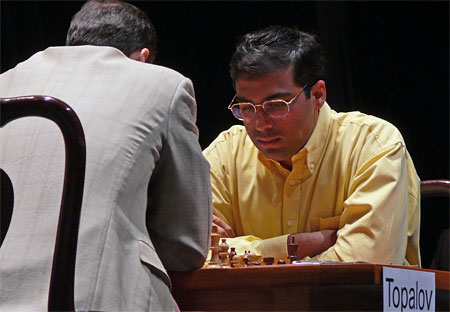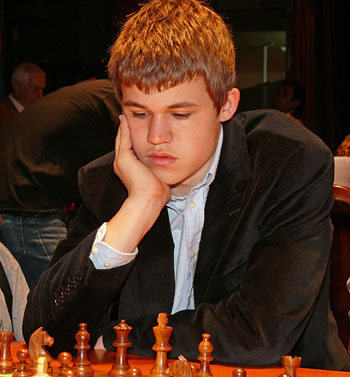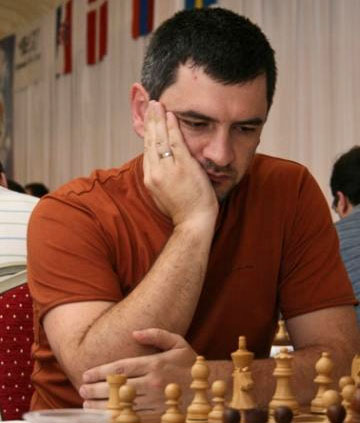| Latest | Greatest | Lobby | Journals | Search | Options | Help | Login |
|
|
|
This topic is archived. |
| Home » Discuss » Topic Forums » Sports |
|
| Jack Rabbit
|
Fri Feb-01-08 02:06 PM Original message |
| Jack Rabbit Chess Report: Nakamura comes from behind to win Gibralter |
|
Nakamura wins Gibraltar Open
 Photo: British Airways American grandmaster Hikaru Nakamura, 20, won the Gibtelecom Masters Tournament in Gibraltar by defeating grandmaster Bu Xiangzhi of China in a two-game rapid playoff, 2-0, on Thursday. Nakamura, who is a native of Japan, won his game in the tenth and final round earlier on Thursday to surpass then-co-leader Zahar Efimenko of Ukraine to catch Bu in the standing at 8 point a piece. Nakamura began slowly, with only three points in the first half of the tournament, a point and a half behind the leaders. However, he won his remaining five games to force the playoff Bu had either been alone in the lead or tied for it since the fifth round Sunday. He entered the ninth round Wednesday leading by a full point over his nearest rivals, but was defeated by Efimenko. Had Bu won the game, he would have clinced first prize. Bu drew his tenth-round game Thursday against his fellow countryman, Ni Hua. Bus last victory came in the eighth round against Moldovas Viorel Bologan, who was making a late bid to join the leaders. Bologan, Efimenko, Ni and four others ended tied for third with 7½ points each. After winning the first playoff game against Bu, Nakamura needed only a draw in the second to claim the tournament title. When Bu, for whom a draw was no better than a loss, saw that he could not win the second game, he allowed himself to be checkmated. Four women shared the prize for best female player with 6½ points each. They were: former womens world champion Antoaneta Stefanova of Bulgaria, who was alone in the lead after four rounds; Lithuanian master Viktorija Cmilyte; Indias Harika Dronavalli; and Georgia native Ketevan Arakhamia-Grant, who was making her first appearance under the flag of Scotland, where she has lived for ten years. A total of 203 players participated in this years event. Calendar The Moscow Open begins tomorrow, February 2. Participants number 291 as of today. The top seeds are Vladimir Akopian of Armenia and Russian grandmasters Vladimir Malakhov, Ernesto Inarkiev and Vadim Zviaginnsev. The Swiss system tournament is nine rounds and ends February 10. The Aeroflot Open, another prestigious nine-round Swiss system event, begins Thursday, February 14, in Moscow. Last years event was won by the 2007 Russian national champion, Evgeny Alekseev. The list of players is not yet complete but as of now includes the fifteen-year-old Italian national champion, Fabianao Caruana, who took first prize in the Corus C group in Wijk aan Zee in January. Finally, the Morelia-Linares Tournament of elite grandmasters starts in Morelia, Michoacán (Mexico) on February 15. The first half of the double round robin event concludes February 23. The second robin begins February 28 in Linares, Andalucia (Spain) and finishes March 7. This years participants are: world champion and defending tournament champion Vishy Anand of India; this years Corus A co-champions Levon Aronian of Armenia and Magnus Carlsen of Norway; Vassily Ivanchuk of Ukraine; Hungarian grandmaster Peter Leko; Azerbaijans Teimour Radjabov; Latvian-Spanish grandmaster Alexei Shirov; and former FIDE world champion Veselin Topalov of Bulgaria. |
| Printer Friendly | Permalink | | Top |
| Jack Rabbit
|
Fri Feb-01-08 03:18 PM Response to Original message |
| 1. Games from Corus A: |
| Printer Friendly | Permalink | | Top |
| Jack Rabbit
|
Fri Feb-01-08 03:20 PM Response to Reply #1 |
| 3. Aronian - van Wely, Round 11, Wijk aan Zee |
 Levon Aronian Levon Aronian - Loek van Wely Corus Chess Tournament, Group A, Round 11 Wijk aan Zee, 25 January 2008 Slav Queen's Gambit: Tikhi Opening 1.d4 d5 2.c4 c6 3.Nf3 Nf6 4.e3 a6 5.Nc3 b5 6.c5 Nbd7
7.Bd3
7...e5 8.Nxe5 Nxe5 9.dxe5 Ng4 10.f4 Bxc5 11.Qf3 Qb6 12.Ke2
12...Nh6
13.h3 Nf5 14.g4 Ne7
15.Rb1!?
15...a5 16.e4 Bb7 17.f5
17...Bd4?
18.exd5?
18...Bxe5
19.Be3 Qc7 20.Rbc1
20...b4?
21.dxc6 Bxc6
22.Ne4 Rd8
23.f6 Nd5
!""""""""# $ + Tl+ T% $+ W +oOo% $ +v+ P +% $O +mV + % $ O +n+p+% $+ +bBq+p% $pP +k+ +% $+ R + +r% /(((((((() WHITE: Levon Aronian Position after 23...Ne7d5 24.Rxc6!!
24...Qxc6 25.Rc1 Qd7
26.Nd6+
26...Qxd6 27.Bb5+!
27...Kf8 28.Bc5 Nf4+
29.Ke1 gxf6 30.Bxd6+ Rxd6
31.Rc8+ Kg7 32.Rxh8 Kxh8 33.Qb7
33...Kg7
34.Be8 Kh6 35.Qxf7 Ng6 36.Qb3 Nf4
37.Qg8 Rd4?
38.h4!
38...Ng2+
39.Ke2 Nxh4 40.g5+ fxg5 41.Qe6+ 1-0
|
| Printer Friendly | Permalink | | Top |
| Jack Rabbit
|
Fri Feb-01-08 03:22 PM Response to Reply #1 |
| 4. Carlsen - Anand, Round 11, Wijk aan Zee |
 Vishy Anand Magnus Carlsen - Vishy Anand Corus Chess Tournament, Group A, Round 11 Wijk aan Zee, 25 January 2008 Open Sicilian Game: Najdorf-Scheveningen Defense 1.e4 c5 2.Nf3 d6 3.d4 cxd4 4.Nxd4 Nf6 5.Nc3 a6 6.Be2 e6 7.a4 Nc6 8.0-0 Be7 9.Be3 0-0 10.f4 Qc7 11.Kh1 Re8 12.Bf3
12...Rb8
13.Qd2
13...Bf8 14.Qf2 Bd7
15.g4!?
15...e5
16.Nf5 exf4!?
17.Bxf4 Be6
18.Rad1?!
18...Ne5!
19.Bxe5 dxe5 20.g5 Nd7
21.Nd5 Qc6 22.Bg2?!
22...Qc5 23.Qh4?!
23...Qxc2 24.Rc1?
24...Qxa4 25.b3 Qa5 26.Rc3 g6
27.Rh3 h5 28.Bf3
28...Bxd5 29.exd5 Bg7
30.Bxh5
!""""""""# $ T +t+l+% $+o+m+oV % $o+ + +o+% $W +pOnPB% $ + + + Q% $+p+ + +r% $ + + + P% $+ + +r+k% /(((((((() WHITE: Magnus Carlsen Position after 30.Bf3h6:p 30...gxf5!!
31.Bxf7+
31...Kxf7 32.g6+ Kg8 33.Qh7+
33...Kf8 34.Rxf5+ Ke7 35.Qxg7+ Kd6 36.Rf7 Qxd5+
37.Kg1 Rbd8
38.Rh7 Qd4+ 39.Kg2 Qg4+ 40.Kh1
40...Rg8 41.Rf6+
41...Kc7 42.Qe7 Qe4+ 0-1
|
| Printer Friendly | Permalink | | Top |
| Jack Rabbit
|
Fri Feb-01-08 05:47 PM Response to Reply #1 |
| 9. Kramnik - Carlsen, Round 12, Wijk aan Zee |
 Magnus Carlsen Vladimir Kramnik - Magnus Carlsen Corus Chess Tournament, Group A, Round 12 Wijk aan Zee, 26 January 2008 English Game: Symmetrical Defense 1.Nf3 Nf6 2.c4 e6 3.Nc3 c5 4.g3 b6 5.Bg2 Bb7 6.0-0 Be7 7.d4
7...cxd4 8.Qxd4
8...d6 9.Rd1 a6 10.Ng5
10...Bxg2 11.Kxg2 Nc6 12.Qf4 0-0 13.Nce4
13...Ne8 14.b3 Ra7 15.Bb2 Rd7!?
16.Rac1
16...Nc7
17.Nf3 f5 18.Nc3 g5!?
19.Qd2
19...g4 20.Ne1
20...Bg5 21.e3 Rff7
22.Kg1 Ne8 23.Ne2
23...Nf6 24.Nf4
24...Qe8 25.Qc3 Rg7 26.b4 Ne4 27.Qb3
27...Rge7 28.Qa4
28...Ne5 29.Qxa6?
!""""""""# $ + +w+l+% $+ +tT +o% $qO Oo+ +% $+ + MoV % $ Pp+mNo+% $+ + P P % $pB + P P% $+ RrN K % /(((((((() WHITE: Vladimir Kramnik Position after 29.Qa4a6:p 29...Ra7!
30.Qb5
30...Qxb5 31.cxb5 Rxa2 32.Rc8+
32...Kf7 33.Nfd3
33...Bf6 34.Nxe5+
34...dxe5 35.Rc2 Rea7 36.Kg2
36...Ng5 37.Rd6
37...e4 38.Bxf6 Kxf6 39.Kf1
39...Ra1 40.Ke2 Rb1 41.Rd1
41...Rxb4 42.Ng2 Rxb5 43.Nf4
43...Rc5 44.Rb2 b5 45.Kf1 Rac7 46.Rbb1 Rb7 47.Rb4
47...Rc4 48.Rb2
48...b4 49.Rdb1 Nf3 50.Kg2 Rd7 51.h3 e5
52.Ne2 Rd2 53.hxg4
53...fxg4 54.Rxd2 Nxd2 55.Rb2
55...Nf3 56.Kf1 b3 57.Kg2 Rc2 0-1
|
| Printer Friendly | Permalink | | Top |
| Jack Rabbit
|
Fri Feb-01-08 03:18 PM Response to Original message |
| 2. Games from Gibraltar: |
| Printer Friendly | Permalink | | Top |
| Jack Rabbit
|
Fri Feb-01-08 03:23 PM Response to Reply #2 |
| 5. Bologan - Stefanova, Round 7, Gibraltar |
 Viorel Bologan Viorel Bologan - Antoaneta Stefanova Gibtelecom Masters, Round 7 Gibralter, 28 January 2008 Spanish Grand Royal Game: Neo-Classical Defense 1.e4 e5 2.Nf3 Nc6 3.Bb5 a6 4.Ba4 Nf6 5.0-0 Bc5 6.c3 b5 7.Bb3 d6 8.d4 Ba7
9.h3 0-0!?
10.Bg5
10...Bb7
11.Qd3?!
11...h6 12.Bh4 exd4 13.cxd4 g5 14.Nxg5?
14...hxg5 15.Bxg5 Nxd4!
16.Nc3 Kg7 17.Rae1 Ne6 18.Bh4 Nf4 19.Qg3+
19...Ng6 20.Nd5
20...Bxd5 21.exd5
21...Bd4 22.Bg5 b4
23.h4 Rh8 24.Bc2 Qd7 25.Re6
25...Nxd5 26.Rxg6+ fxg6
27.Qd3 Bxb2 28.Qxd5 Qf7 29.Qe4 Bf6 30.Bb3
30...Qf8?
31.Rc1 Rc8 32.Be6 Qe7 33.Bxf6+ Qxf6?
34.Bxc8 Rxc8 35.Qxb4 Kh8 !""""""""# $ +t+ + L% $+ O + + % $o+ O Wo+% $+ + + + % $ Q + + P% $+ + + + % $p+ + Pp+% $+ R + K % /(((((((() WHITE: Viorel Bologan Position after 35...Kg7h8 36.Rxc7!!
36...Qa1+ 37.Kh2 Rxc7 38.Qb8+ Kg7 39.Qxc7+ Kh6 40.Qf7!
40...Qe5+ 41.Kh3 Qe1
42.Qg8
42...Qh1+ 43.Kg3 Qa1 44.Qc4 Kh7 45.Qf7+
45...Kh6 46.Qf8+ Kh7 47.Qe7+ Kh6 48.Qg5+ Kh7 49.h5!
49...gxh5
50.Qxh5+ Kg7 51.Qd5 Qc3+ 52.f3 Qe1+ 53.Kg4 Qb4+ 54.f4 a5
55.Kf5 a4 56.Kg5 Qb2 57.g3 Qb6
58.Qe6 Qd8+
59.Kh5 d5 60.Qg6+ Kf8 61.Qf5+ Ke8
62.Qe6+ Kf8 63.Kg6 Qc7 64.Qf5+ Ke8 65.Qxd5 Qc2+
66.Kg5
66...Qf2 67.g4 Ke7 68.Qe5+
68...Kf7 69.Qc7+ Ke8 70.Kf6 Qh4+ 71.g5 Qh8+ 72.Qg7 1-0
|
| Printer Friendly | Permalink | | Top |
| Jack Rabbit
|
Fri Feb-01-08 03:27 PM Response to Reply #2 |
| 6. Bu - Bologan, Round 8, Gibraltar |
 Bu Xiangzhi Bu Xiangzhi - Viorel Bologan Gibtelecom Masters, Round 8 Gibraltar, 29 January 2008 West India Game: King's Indian Defense (Panno Variation) 1.Nf3 Nf6 2.c4 g6 3.g3 Bg7 4.Bg2 0-0 5.0-0 d6 6.d4 Nc6 7.Nc3 a6 8.b3
8...Rb8 9.Nd5 e6
10.Nxf6+ Qxf6 11.Bg5
11...Qf5 12.Qd2 Nxd4 13.Nxd4 Bxd4 14.Qxd4 Qxg5 15.Qa7 Bd7 16.Bxb7 a5 17.Rfd1
17...Rfd8 18.Bf3!?
18...Qc5? !""""""""# $ T T +l+% $Q Ov+o+o% $ + Oo+o+% $O W + + % $ +p+ + +% $+p+ +bP % $p+ +pP P% $R +r+ K % /(((((((() WHITE: Bu Xiangzhi Position after 18...Qg5c5
19.Qxc5 dxc5 20.Rd3 Kf8
21.Rad1 Ke7 22.Re3
22...a4
23.Rd5 axb3 24.axb3 Ra8
!""""""""# $t+ T + +% $+ OvLo+o% $ + +o+o+% $+ Or+ + % $ +p+ + +% $+p+ RbP % $ + +pP P% $+ + + K % /(((((((() WHITE: Bu Xiangzhi Position after 24...Rb8a8 25.Rxc5
25...Ra7
26.Rd3 Rb8
27.e4 f6 28.e5 f5
29.g4
29...fxg4 30.Bxg4 Rf8
31.b4 c6
32.Bf3 Rb8 33.Bxc6?!
33...Rxb4 34.Rh3 h5 35.Be4
35...Be8 36.Kg2 g5 37.Rg3 g4 38.h3 Rd7
39.hxg4 Rd4
40.Bf3 h4 41.Rh3 Rbxc4 42.Rxc4 Rxc4 43.Rxh4
43...Rc5 44.Rh7+ Kf8 45.Rh8+ Ke7 46.Rh7+ Kf8 47.Kg3 Rxe5 48.Kf4
48...Ra5 49.Rh8+ Ke7 50.Be4 Ra4
51.Rh7+
51...Kf8
52.f3 Bg6 53.Rb7 Bxe4 54.fxe4 Ra5
55.g5 Rc5 56.g6 Rh5
57.Rh7
57...Ra5 58.e5 Kg8
59.Rd7 Rb5 60.Ra7 Rb1 61.Kg5 Rf1 !""""""""# $ + + +l+% $R + + + % $ + +o+p+% $+ + P K % $ + + + +% $+ + + + % $ + + + +% $+ + +t+ % /(((((((() WHITE: Bu Xiangzhi Position after 61...Rb1f1
62.Rf7 Rg1+ 63.Kf6 Rf1+ 64.Kxe6 Rg1
65.Kf6 Rf1+ 66.Ke7 Rg1 67.e6!
67...Rxg6 68.Rf1 Kg7 69.Kd7 Rg2 70.e7 Rd2+ 71.Ke8 Ra2 72.Rg1+ Kh7 73.Re1
|
| Printer Friendly | Permalink | | Top |
| Jack Rabbit
|
Fri Feb-01-08 03:29 PM Response to Reply #2 |
| 7. Efimenko - Bu, Round 9, Gibraltar |
 Zahar Efimenko Zahar Efimenko - Bu Xiangzhi Gibtelecom Masters, Round 9 Gibraltar, 30 January 2008 Open Sicilian Game: Najdorf-Boleslavsky Defense 1.e4 c5 2.Nf3 d6 3.d4 cxd4 4.Nxd4 Nf6 5.Nc3 a6 6.Be2 e5 7.Nb3 Be7 8.0-0 0-0 9.Re1
9...Be6 10.Bf3
10...Nbd7 11.a4 Rc8
12.a5 Qc7 13.Be3 Rfd8 14.Nd2 h6 15.Nf1 Bf8!?
16.h3
16...g6
17.Nh2 h5 18.Nf1 Bg7 19.Bg5
19...Rb8
20.Ne3 Rdc8 21.Be2 Qc6
22.Bd3 Re8 23.Bh4 Nh7?
24.Ncd5!
24...Bxd5 25.Nxd5 Nhf6 26.c4
26...Nxd5 27.cxd5 Qc7 28.Bg5
28...Bf6 29.Be3 Rec8 30.Qd2 Qd8
31.b4 Kh7 32.Rac1 Bg7 33.Rxc8 Rxc8 34.Rc1 Rc7
35.g3 Nf6 36.Kg2 Rxc1 37.Qxc1 Qd7
38.Qc2?!
38...Bh6 39.Bb6?
39...h4
40.g4
40...Nxg4?
41.Qc7!
41...Nf6
42.Qxd7 Nxd7 43.Bc7 Kg8
!""""""""# $ + + +l+% $+oBm+o+ % $o+ O +oV% $P +pO + % $ P +p+ O% $+ +b+ +p% $ + + P +% $+ + + + % /(((((((() WHITE: Zahar Efimenko Position after 43...Kh7g8 44.Bxa6!!
44...Bd2
45.Bxb7 Bxb4 46.a6 Bc5 47.Bc6 1-0
|
| Printer Friendly | Permalink | | Top |
| Jack Rabbit
|
Fri Feb-01-08 03:30 PM Response to Reply #2 |
| 8. Nakamura - Efimenko, Round 10, Gibraltar |
 Hikaru Nakamura Hikaru Nakamura - Zahar Efimenko Gibtelecom Masters, Round 10 Gibraltar, 31 January 2008 King's English Game: Fianchetto Opening 1.c4 Nf6 2.Nc3 e5 3.g3 Bb4 4.Bg2 Bxc3
5.bxc3
5...0-0 6.d3 d6 7.e4 Nc6!?
8.Ne2 Bd7
9.h3!?
9...Ne8 10.0-0
10...a6
11.a4 b6 12.f4
12...exf4?
13.Bxf4
13...Ne5 14.Nd4 g6
15.Nc2
15...Ng7 16.Ne3 f6
!""""""""# $t+ W Tl+% $+ Ov+ Mo% $oO O Oo+% $+ + M + % $p+p+pB +% $+ PpN Pp% $ + + +b+% $R +q+rK % /(((((((() WHITE: Hikaru Nakamura Position after 16...f7f6 17.d4!
17...Nf7 18.g4 c6
19.Ra2 Ne6
20.Bg3 Neg5
21.Qd3 Qe7 22.h4 Ne6 23.Rb2
23...Rab8 24.Rbf2 Nh6
!""""""""# $ T + Tl+% $+ +vW +o% $oOoOmOoM% $+ + + + % $p+pPp+pP% $+ PqN B % $ + + Rb+% $+ + +rK % /(((((((() WHITE: Hikaru Nakamura Position after 24...Nf7h6 25.c5!!
25...bxc5 26.dxc5 Nxc5 27.Qxd6 Qxd6 28.Bxd6
28...Nxa4 29.Bxf8 Rxf8 30.g5 Ng4 31.Nxg4 Bxg4 32.Rxf6 Rc8
33.R1f4 Bd7 34.Bf1 1-0
|
| Printer Friendly | Permalink | | Top |
| DU
AdBot (1000+ posts) |
Thu Apr 25th 2024, 11:40 PM Response to Original message |
| Advertisements [?] |
| Top |
| Home » Discuss » Topic Forums » Sports |
|
Powered by DCForum+ Version 1.1 Copyright 1997-2002 DCScripts.com
Software has been extensively modified by the DU administrators
Important Notices: By participating on this discussion board, visitors agree to abide by the rules outlined on our Rules page. Messages posted on the Democratic Underground Discussion Forums are the opinions of the individuals who post them, and do not necessarily represent the opinions of Democratic Underground, LLC.
Home | Discussion Forums | Journals | Store | Donate
About DU | Contact Us | Privacy Policy
Got a message for Democratic Underground? Click here to send us a message.
© 2001 - 2011 Democratic Underground, LLC